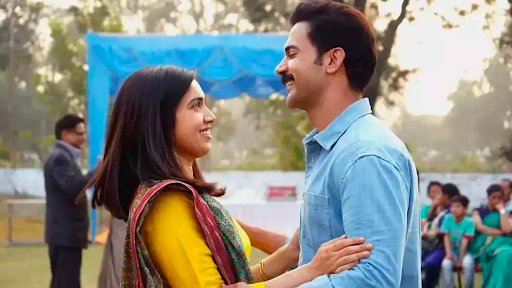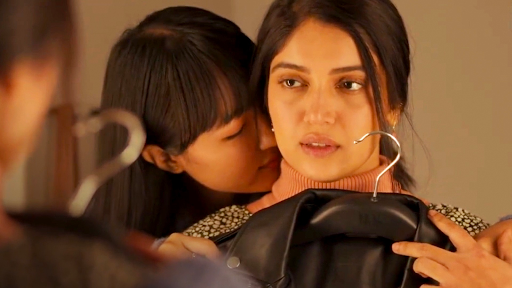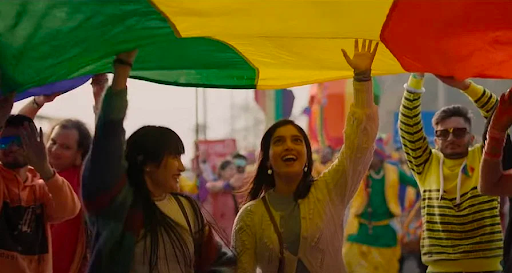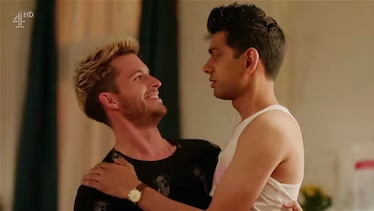|
2/7/2024 0 Comments Badhaai Do and Gay MasculinityPadma (she/her)One evening during winter break, I came downstairs, and was met with a familiar sight: my mom relaxing after work by watching something on the TV. Seeing the screen and hearing the Hindi language, I assumed it was another Hindi drama series that she likes, and almost left without saying anything. Luckily, she told me she was watching Badhaai Do (translation: “Congratulations”), a 2022 movie that had just begun. I decided to watch it with her, possibly the best decision I made over break. Badhaai Do is a comedy about “beards” who marry to protect their true identities. After police officer Shardul Thakur and physical education teacher Sumi Singh meet, Thakur comes to know Sumi’s identity as a lesbian when she reports that someone is threatening to out her. After speaking to her tormentor and ensuring Sumi’s safety, Thakur wants to remain in touch, relieved to finally meet someone else who shares his homosexual identity. After proposing that they get married to keep their identities hidden, Sumi agrees and a traditional, grandiose Indian wedding ensues. Having to continue hiding their true selves from both of their families, and the people around them, they are extra careful as they both maintain relationships with same-sex partners, having to lie about who they are. The movie is not only great in terms of representation, but proposes a genuine and interesting storyline that at the surface comes off as a comedy, but truly highlights issues with Indian culture. It follows a typical Bollywood formula with two near-strangers getting married and slowly growing closer, but instead of taking an easy way out,ending with the characters getting together, the movie keeps them true to their identities as gay people. Similar to Ek Ladki Ko Dekha Toh Aisa Laga, another recent LGBT+ Bollywood movie, this film’s comedy is centered around funny situations, rather than having gay people be the butt of the joke. For example, when Sumi brings over a woman that she’s seeing to their house, they have to explain to neighbors or families who this woman is. Sumi and Shardul both trade off in claiming she is their “cousin” based on who is asking, so as not to get caught. The absurdity of the situation is what encompasses the humor, not any negative qualities about the characters. The storyline itself focuses on the difficulties of being queer in a generally conservative society, rather than internal acceptance or learning about one’s own sexuality. While both aspects of queer identity are important in one’s journey, it is refreshing to see a movie about the former, and it too being a comedy, not a tragedy. While the film critiques Indian society, and society as a whole, the movie doesn’t presume that all Indians are homophobic or unaccepting, by describing a range of levels of acceptance among many characters. Though a heartbreaking scene occurs when both Sumi is accidentally caught with her “real” partner, many of the people spewing homophobic words to her come around, albeit slowly. In the film Thakur is placed on duty to watch a gay “wedding” (still not legal) and ensure that nothing violent happens, highlighting that there are openly gay people in India, and that there is hope for LGBT+ people to come out. Finally, the end of the movie shows Sumi and Thakur, along with their same-sex partners, joining a pride parade, and celebrating their identity with many other Indians in their community. The film ends with a happy ending, and Sumi even getting what she always wanted, a baby, who they adopted. Considering that homosexual relationships were only recently decriminalized in 2018, this movie represents the astounding amount of progress being made in India to become more accepting. This too, on a personal level, is highlighted by the fact that I could watch the film with my mom, who enjoyed the movie, and who is much more accepting of me and other queer people, than she would have been in her youth. There is a perception that third world countries have completely homophobic sentiments and are entirely conservative; while it’s true that many have stricter laws surrounding homosexuality, these do not necessarily encompass the true sentiments of the people. There are millions, billions even, of people in these countries and it is unfair to generalize them in such a way. The movie highlights the diversity of thought in current Indian society and even shows how a family can grow. However, another interesting aspect of this movie is how they were able to refrain from feminizing the main character, Shardul, despite him being both gay and Indian. He in fact remains traditionally masculine, bordering sexist, and in an odd way, this is a strength of the movie. It is no secret that Indian men are often feminized in western culture, and Indian culture is viewed as the wrong type of masculinity. From bright colors and the popularity of Bollywood dances, it is strange to westerners how leading men are depicted in ways that seem so feminine. This extends past media; Indian men are considered “feminine” in many ways due to their (generally) smaller stature. This perception began during colonial times, when European men attempted to depict Indian men as weaker, and therefore in need of rulers. It stems from racist interpretations of Indian culture, and was originally a justification for colonization, which has remained even decades later. It goes without saying that these perceptions can negatively impact brown men today, with their identity and cultural expression being cumbersome to navigate. Furthermore, gay men throughout history have also, always been feminized. Though in different ways, gay men are subjected to ridicule, and are often unable to display themselves as traditionally masculine because of societal expectations placed on them. Although many gay men find comfort in a “feminine” identity, or with a unique, distinctively queer identity, this feminization may have originally been a form of degradation and ostracization. After all, many men’s biggest fear is to be like a woman. Of course this sentiment is problematic in it’s own way, and there is nothing degrading about being a woman, I do believe it is every man’s, every person’s, right to present themselves in whatever way feels most comfortable to them, including being traditionally masculine. Naturally, with both these identities being associated with feminization, it makes sense that gay Indian men, particularly in western media, are portrayed as hyper-feminine, weak, or infantilized. For example, in the show Crashing, Fred is portrayed as weak, even in a literal sense, having diabetes that makes him have to eat sugar to prevent himself from passing out. He is often jokingly pushed around by his friend Sam, and has to finally exclaim “I’m a man!” in a desperate attempt to stop the infantilization from his friends. Though there are many great aspects of this show, including Fred’s comfortability with his sexuality, his demeanor is ultimately an easy stereotype that is taken advantage of. Despite these pretexts, Badhaai Do’s Shardul effectively breaks these stereotypes about what it means to be a gay Indian man. Shardul is strong, he works out, and he’s a police officer: the ultimate figure of authority. He is in no way hyper-feminized or infantilized, and stands his ground. Most importantly he represents what many story writers forget: gay men are still men. His sexuality doesn’t excuse his sexism that is shown subtly in the movie. Even during his marriage, that is fully for show, he expects Sumi to do more of the housework, and to attend to guests in a way that a typical wife would. He is expected to take the master bedroom and often attempts to take control of their situation by telling Sumi what to do. Gay men aren’t necessarily immune from sexism, and the movie purposefully shows the audience that. His sexuality and his masculinity are retained. Furthermore, another example of gay men’s masculinity being retained is shown when Shardul’s later partner, Guru Narayan, explicitly doesn't want a child, even when Sumi and Shardul are excited to adopt one. The differences in the two men show that there is no monolith among the queer Indian community, and that even gay men do not want to have children. Guru also isn’t shown to be particularly rude or disrespectful towards women, again highlighting the diversity in thought and action among the people of the movie. So while Shardul can represent typical male sexism, that isn’t the only way of being. Thus, in an ironic way, having Shardul be controlling, and even subtly sexist, the writers beautifully break stereotypes about gay Indian men and masculinity. That’s not to say that sexism should be excused in any sense, but rather the inclusion of it further highlights issues within the LGBTQ+ community, and still allows Shardul to take on the many faces of masculinity. All in all, Badhaai Do, a movie that is on Netflix right now, is certainly worth a watch. The film purposefully highlights both issues and progress within Indian culture and the queer community, but more than anything, is a lighthearted movie with two gay romances. It doesn’t get much better than that! More than anything, movies like these represent a broader importance of bringing queer people and identities into a family tradition. Many bollywood movies are watched with family, and the fact that I could enjoy a gay movie with my mom, about our culture, means the world.
0 Comments
Leave a Reply. |
Categories |
Search by typing & pressing enter




